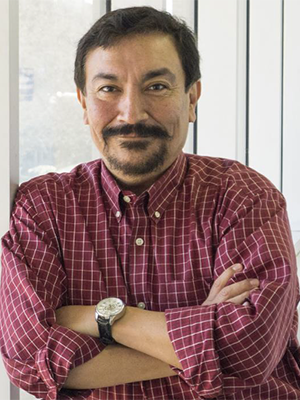
Samuel Márquez, PhD
Professor
Department of Cell Biology and Otolaryngology
Co-Director of Anatomy of College of Medicine, Director of Anatomy, School of Health
Professions, Director of the Anatomical Donor Program
Samuel Márquez is a Professor in the Departments of Cell Biology and Otolaryngology at SUNY Downstate Health Sciences University. He is a functional craniofacial comparative anatomist whose research interests are in the evolution of the nose and paranasal sinuses and its clinical relevance, particularly in the area of sinusitis. His area of expertise is on the comparative anatomy of the nose and paranasal sinuses of living and extinct humans, great apes, monkeys and terrestrial mammals. He is grounded in traditional gross anatomic dissection, morphometrics of dry skulls, and CT & MR imaging to understand human diversity of living populations. Dr. Márquez research has taken him to museums in Central and South America, Europe and the U.S. to examine and measure diversity across numerous skull specimens housed in their osteological collections. Research goals are centered on questions concerning human origins that are driven by the theme of primate and human evolution with direct relevance to clinical consequences. He has scanned a large number of crania housed in the Division of Anthropology and Mammalogy at the American Museum of Natural History including Egyptian mummies dating to the predynastic era circa 3,600 B.C.E. as well as a Homo erectus calvaria from Indonesia catalogued as Sambungmachan 3 calvaria (SM-3). Dr. Márquez and the team he assembled in 2001 published in The Anatomical Record journal three papers on this curious fossil specimen. Findings were covered in both the international and national press that included The New York Times, NewsDay from New York and from El Tiempo and El Colombiano from the cities of Bogotá and Cali in Colombia, South America.
National Geographic Channel - World's Oldest Child (10:26 Excerpt)
In addition, Discovery News also reported on this anthropological investigation (3:07).
Findings from these papers helped to place the SM- 3 calvaria in the Homo erectus spectrum, exactly where was its place in human evolution was answered by Susan Antón of New York University, a Homo erectus specialist, who asked Sam Márquez to collaborate with her to present a holistic appraisal of Asian Homo erectus cranial variation that culminated in a paper published in the Journal of Human Evolution.
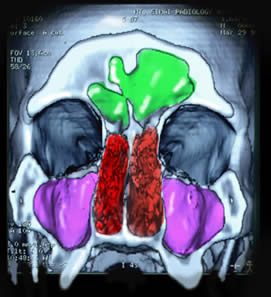
The Márquez collection of MR/CT scanned primate material includes the great apes, lesser apes, and both Old and New World monkeys. His terrestrial mammalian sample includes 12 genera categorized into carnivore, ominivore, frugivore and folivore specimens.
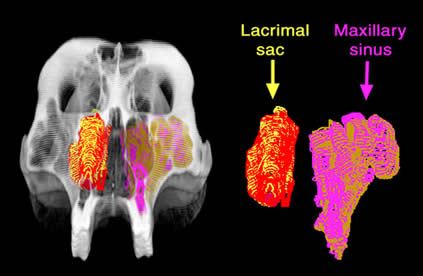
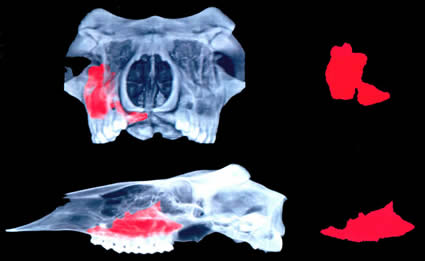
This collection of cranial imaging has permitted Dr. Márquez to develop an unprecedented understanding of intracranial structures of these various mammalian species that are difficult to see otherwise. His work led to a November 2008 issue as a guest editor of a special issue of the Anatomical Record journal entitled: “The Paranasal Sinuses: The Last Frontier in Craniofacial Biology.” Dr. Márquez assembled a Who’s Who of internationally recognized sinus workers that encompasses roughly 65 millions of the Tertiary beginning with the famed Tyrannosaurus rex fossil and its remarkable pneumatized skull, touching on our extinct human ancestors of Neanderthals and their sinus complex, and ending with the health and maintenance of sinus biology in humans. See the impressive front cover of that special issue in the Anatomical Record below.
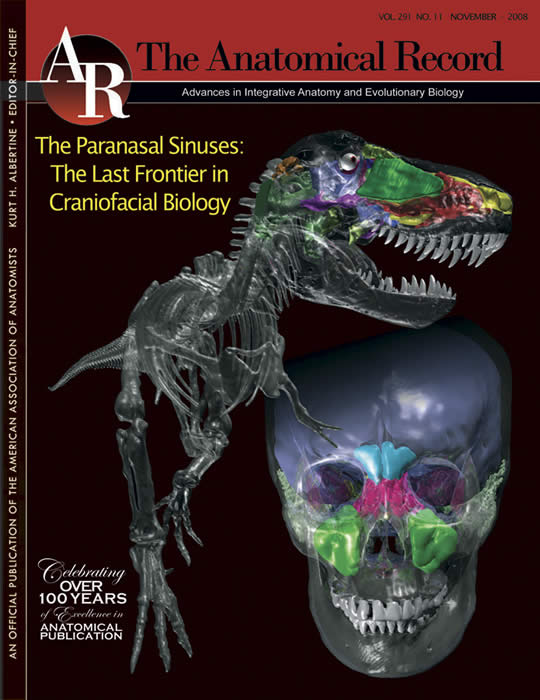
Given that sinusitis initiates a substantial impact on the health and economy in the US afflicting more than 57 million people Dr. Márquez adjusted his career goals specifically to collaborate towards development of proper diagnostic protocols, therapeutic treatments and preventive measure strategies that would provide an invaluable resource to clinicians world-wide. Clinical collaborators include Steven D. Schaefer MD, former Chair and Chief of Sinus Surgery of Otolaryngology from the Eye, Ear Infirmary and William Lawson MD, current Vice-Chair and Eugen Grasbcheid Professor of Sinus Research of Otolaryngology from Icahn School of Medicine at Mount Sinai. He is currently collaborating with Dr. James Zinreich, former Chief of Head & Neck Radiology from Johns Hopkins School of Medicine publishing recently in Rhinology in July 2022 a manuscript entitled: “3D CT Stereoscopic Imaging: Observations of the Frontal and Anterior Ethmoid Sinuses Development from birth to early adulthood.” NSF and NIH have funded Dr. Márquez innovative research, which complement his basic science and clinical objectives.
Dr. Márquez, in 2021, published two manuscripts as a senior author in the Journal of Interventional Radiology (the premier journal for the Interventional Radiologist) and Computational Mathematical Methods in Medicine sponsoring and supporting former Downstate med students who are now well into their residency years of training. His productivity in peer review publications continues in the August 2022 issue of the Anatomical Record where he ushers in, as Co-Guest Editor (Dr. Anthony Pagano the other guest editor), the special issue on the Nasopharynx, completing a three year endeavor of recruiting and shepherding the fourteen articles by international and national authors who have contributed to the issue. From the French otolaryngologist Roger Jankowski who covered the growth and development of the nasopharynx between a time period of half a billion years ago to present day mammals employing the Evo-Devo approach; French paleoanthropologist Antoine Balzeau, from the Musée de l’Homme, who used micro-CT imaging to analyze the internal and external morphological differences of the nasopharynx and skull base of modern humans and Neanderthals; Frank Rühli Dean of the Medical Faculty & Director of the Institute of Evolutionary Medicine in Zurich, Switzerland who focused on Egyptian mummies revealing that the ancient Egyptians had considerable knowledge of the nasopharyngeal region; and Markus Bastir a craniofacial biologist from Spain who analyzed differences in airflow dynamics in the nasopharynges of humans and chimpanzees. American authors are equally represented such as Professor Timothy Smith (Slippery Rock University School of Physical Therapy, Pennsylvania) examining the upper airways of bats, otolaryngologist David Friedland (Medical College of Wisconsin) tracking the region clinically and even illustrating the proper method of swabbing for Covid-19 testing using nasopharyngeal anatomy as a guide. Pagano and Márquez contributed a number of articles to the special issue one of which entitled: The 5,000 year history of study of the nasopharynx providing the framework from which to launch the special issue. They also co-authored an additional paper that was among the first to use nasopharyngeal morphology to analyze the "muddle in the middle" of the Pleistocene fossil record, a controversial period of human evolution predating directly the appearance of modern humans and Neanderthals. Their analysis found evidence of modern human and Neanderthal morphology among fossil specimens from this period, suggesting that the two groups are a product of mutual isolation dating back to this time period. Whether you are a biologist, anatomist, anthropologist, or otolaryngologist, the special issue reports on the body of work that is being undertaken globally on the nasopharynx. The special issue brings up to date all these areas of inquiry and is a must-see issue for those who wish to fully appreciate the region historically, developmentally, evolutionarily, and clinically (see cover page to this special issue that attempts to summarize all the different approaches used to studying the nasopharynx).
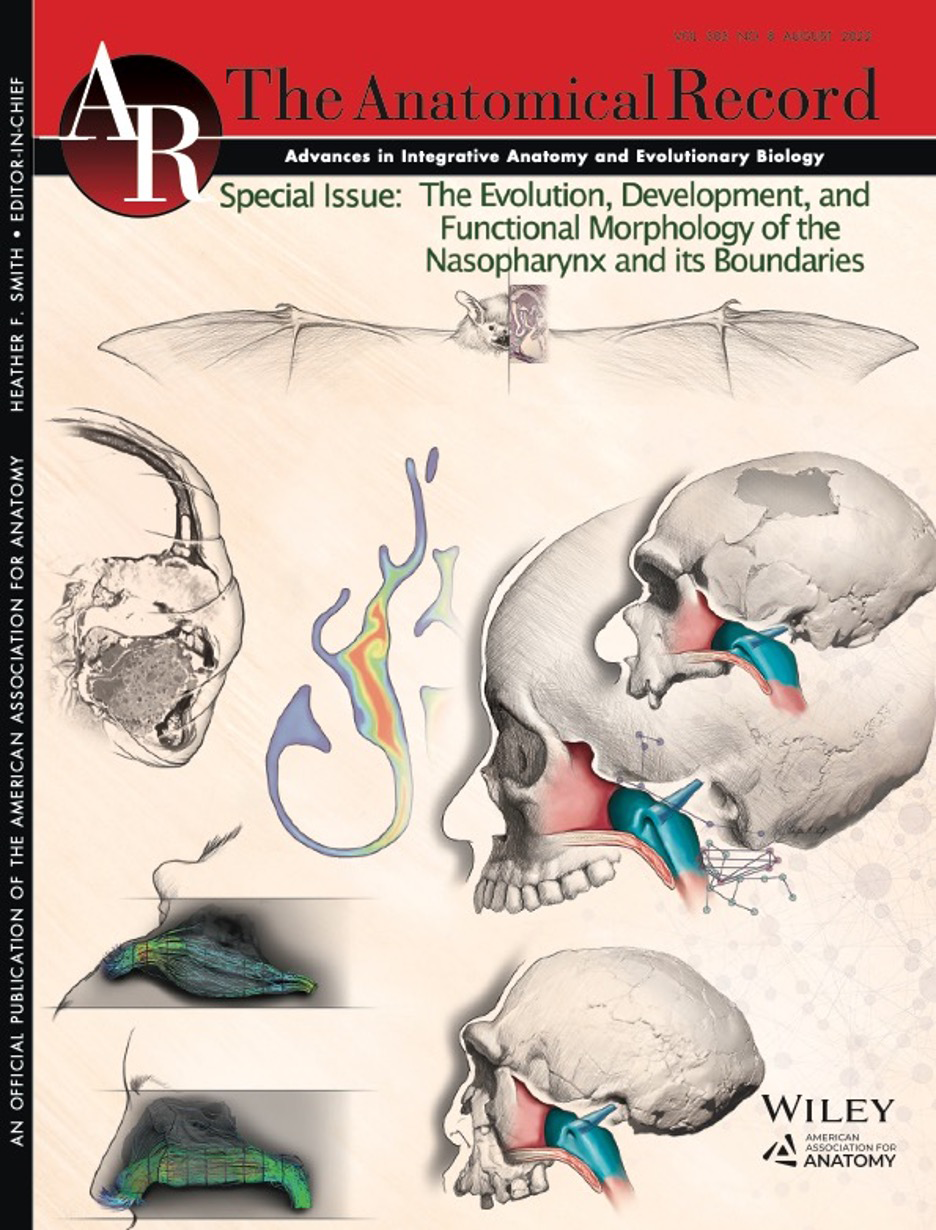
Professor Márquez peer review publications have been featured on a National Geographic documentary on the “World’s Oldest Child” and on The Discovery Channel’s “Discovery News.” Aside to his basic science contribution, he is also a medical educator; serving as Co-Discipline Director of Anatomy at SUNY Downstate’s College of Medicine and is Director of Anatomy in the School of Health Professions. He arrived at SUNY Downstate feeling incredibly welcomed by one of the most diverse student bodies in the country. Dr. Márquez’s instinctive impulse is to give back, which speaks to his dedication of service to the school. His service includes serving as Chair of the Committee on Academic & Professional Qualifications (CAPQ), he currently serves on the Admissions Committee, is a member of the Dean’s Council, and was recently elected to serve on the CAPQ beginning the Fall 2022 semester. Dr. Márquez has a long track record in directing and participating in education outreach programs and is an elected board member of the prestigious American Association for Anatomy. Dr. Márquez also serves as Director of the Anatomical Donor program, which oversees the acquisition, distribution, and final disposition of donor bodies for medical education and research. His sense of fairness and track record of advocacy were recognized when he was elected as Vice President of Academics for UUP’s Downstate Chapter.
Dr. Márquez is Co-Discipline Director of Gross Anatomy of the College of Medicine. He is the Director of Gross Anatomy in the School of Health Professions and Director of the Anatomical Gift program here at SUNY Downstate Health Sciences University.
Dr. Márquez has inspired and sponsored over 215 students from the College of Medicine and nine students from the Physician Assistant and Physical Therapy Programs to undertake research projects that have culminated in abstract publications usually during their first year of their post graduate training. Giving the opportunity to present their work to the American Association for Anatomy meetings under the umbrella of Experimental Biology conference, students have been able to travel to Washington, DC, San Diego, San Francisco, New Orleans, Chicago, and Philadelphia to name a few of the conference onsite meeting locations. Downstate medical students learn to network, hone their presentation skills, and are the natural ambassadors of our school in these professional meetings. Dr. Márquez undertakes this activity to make medical students more marketable when they apply to residency programs displaying their achievement of publication during their first year of medical school, which is an outstanding advancement in their curriculum vitae.
He continues to be a strong advocate for education outreach strategies aimed at increasing awareness for health science careers at the high school level. In 2007 he received the Special Partner in Medical Education Award from the Mount Sinai School of Medicine’s Center for Excellence in Youth Education. The award presentation cited his dedication to medical education and his interest in encouraging high school and college students to pursue careers in the health care field. Dr. Márquez was also the recipient of the Center of Anatomy and Functional Morphology’s Award for Excellence in Medical Education for his singular efforts in fostering excellence in anatomical education across academic levels from pre-college to post graduate students. Collaborations with Dr. Lloyd Sherman, EdD of Mount Sinai School of Medicine pursued implementation of the innovative approach of Dyad Pedagogy (DP) in teaching anatomy to first-year PA and PT students here at Downstate since 2005. DP has been shown to improve engagement and morale, it increases appetite for learning, enhances ability to relate to others, increases self-confidence and self-image, and improves oral expression. Aside from the duties he performs in medical education here at Downstate, Dr. Márquez has offered medical and health profession students the chance to work side by side with him on his research endeavors mentoring under-represented students during their critical first year in medical school. His efforts were recognized in 2019 with the Dedication Service and Mentorship Recognition Award from the Latino Student National Medical Association Chapter sponsored by The Daniel Hale Williams Society. He was awarded two grants from the American Association for Anatomy for education outreach in anatomy in 2010 and again in 2012. Dr. Márquez is extremely grateful for faculty from Downstate and other medical institutions that are asked to participate in these education outreach activities and do so without compensation. The giving of their time and energy displays not only their generosity but their commitment to the goals of education outreach. Some of the faculty who have participated include Dr. Jenny Libien, Chair of Pathology; Dr. Clinton Brown, Professor in the Division of Renal Disease; Katherine Perkins, Associate Professor from the Dept of Physiology and Pharmacology; Mark Silverberg, Professor of Emergency Medicine; Rick Sadovsky, Professor of Family Medicine; Riccardo Bianchi, Associate Dean of Medical Education; Joanne Katz, Chair of the Physical Therapy program, and Michael Lucchesi, Chair of Emergency Medicine. Other faculty outside of Downstate include Directors of Anatomy Distinguished Professor Jeffrey T Laitman - Icahn School of Medicine, Professor Estomih Mtui - Weill Cornell Medicine, Professor Ray Dannenhoffer - Jacobs School of Medicine & Biological Sciences at University of Buffalo, and Professor Michael Smith - Albany Medical College. (And yes, the last two faculty participants made the trip from Upstate New York to NYC to engage with students). These activities have reached hundreds of middle, and high school students with the most recent outreach event occurring in December 2021 targeting our own Downstate allied health students who never had the opportunity to be in an anatomy laboratory due to the Covid-19 pandemic (see images below).
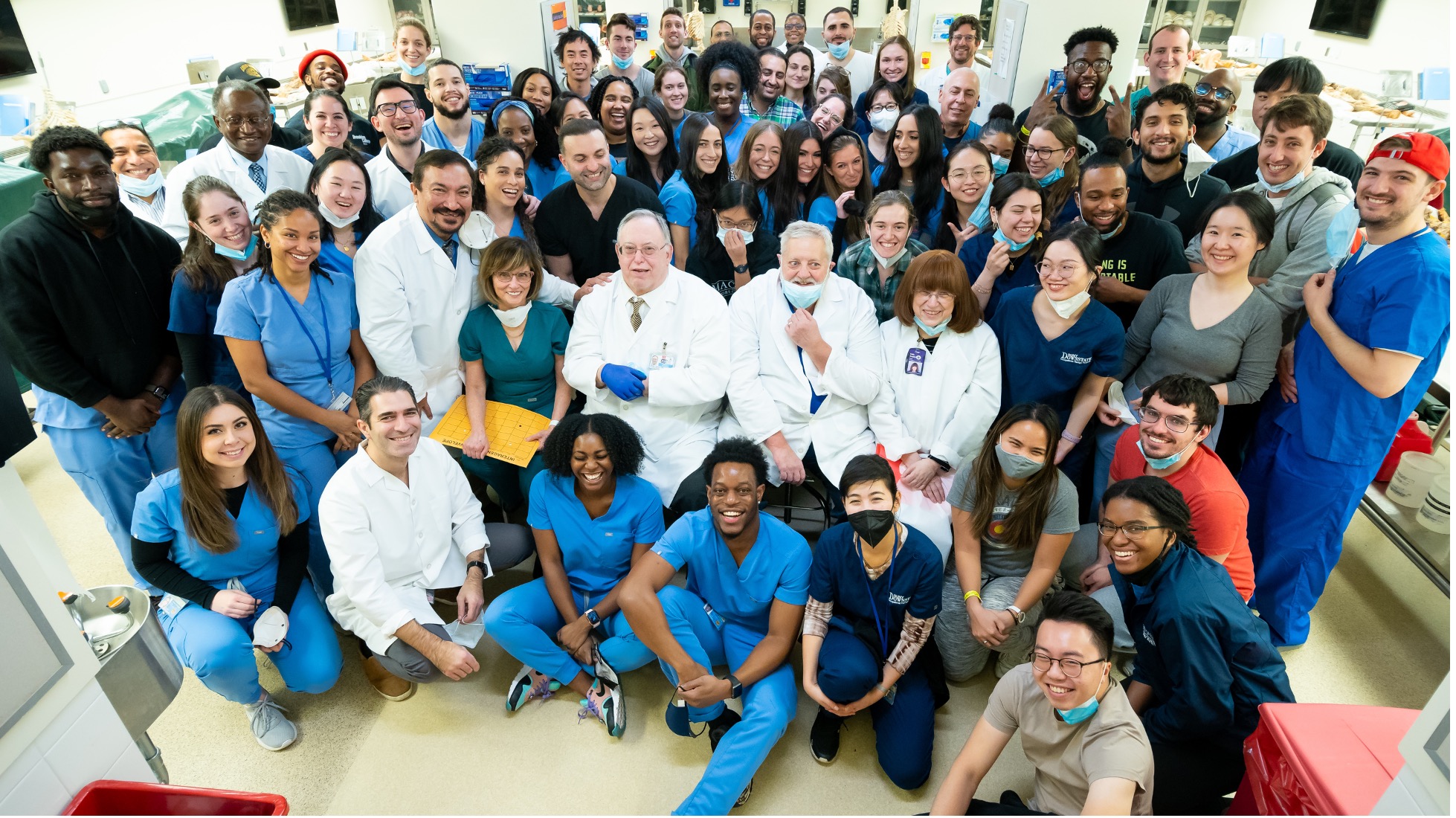
Students, from Downstate’s School of Health Professions, coming from an anatomy remote learning environment and going back to the anatomy lab for an in-person experience that demonstrates the value of hands-on learning for hands-on professionals.
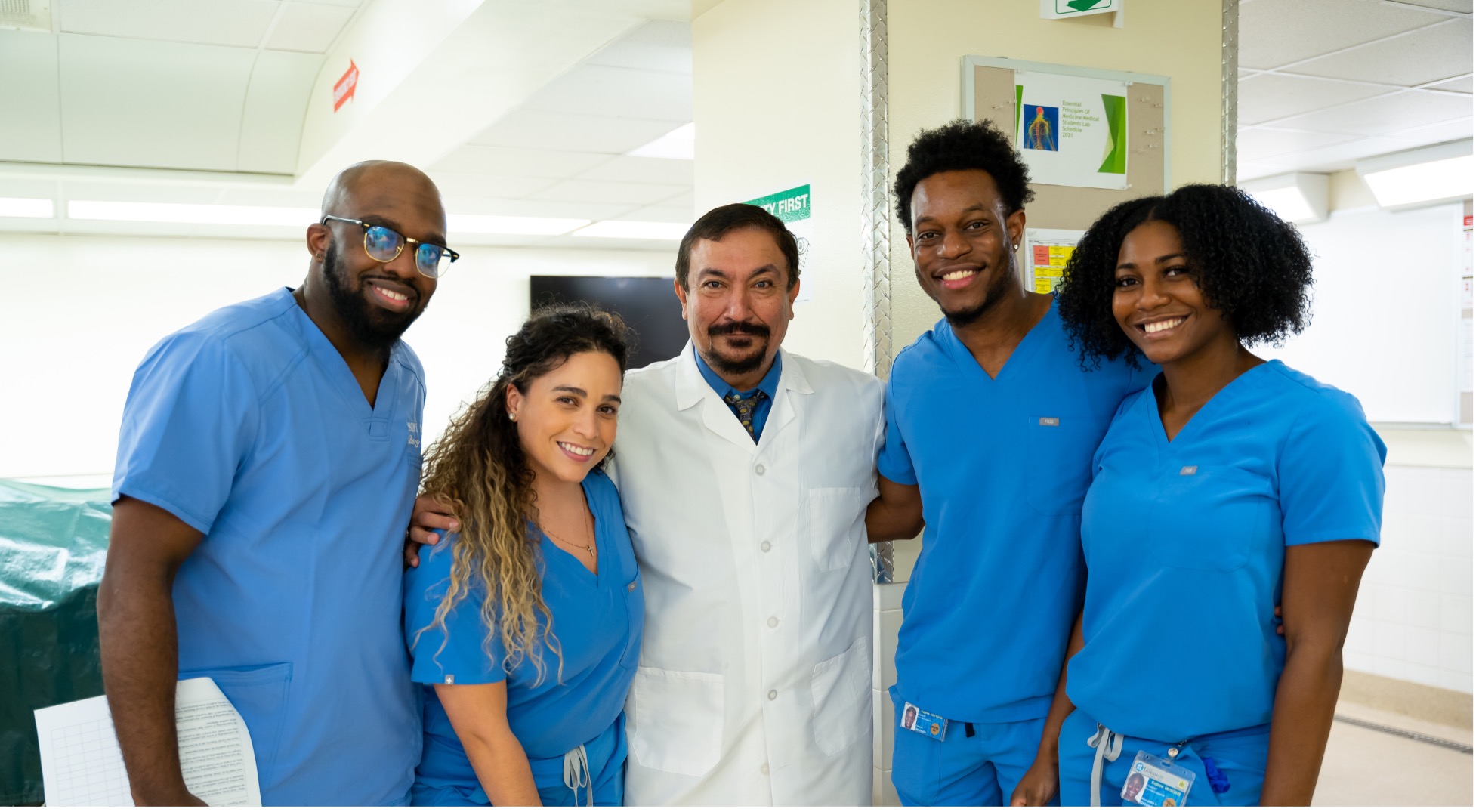
Downstate Health Sciences University strongly believes in having a strong diversity of students that will go on to become the health care providers for our diverse population of patients.
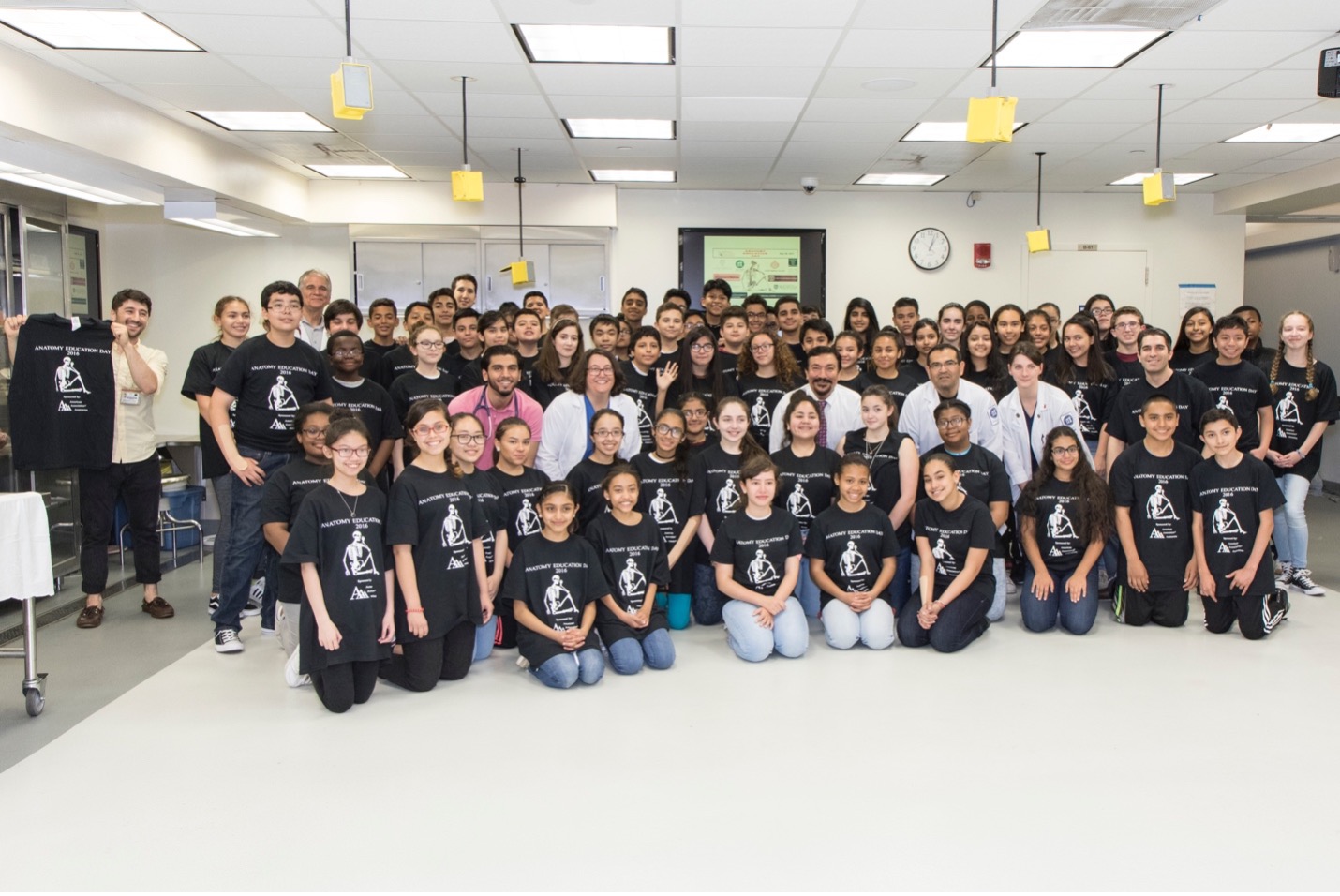
The Márquez philosophy of student outreach activities is to target the students early in order to be most effective in exposing their young minds to a potential path for college bound, and hopefully, post graduate education.
-
Zinreich SJ, Smith TD, Kuhn FA, Márquez S, Solaiyappan M, Hosemann W. (2022) 3D CT Stereoscopic Imaging: Observations of the Frontal and Anterior Ethmoid Sinuses Development from birth to early adulthood. Rhinology Online 5:105-119. http://doi.org/10.4193/THINOL/22.005
-
Pagano AS, Márquez S. (2022). The nasopharynx as a window to half a billion years of evolutionary change to the upper respiratory tract. Anat. Rec. 305:1829-1841.
-
Pagano AS, Márquez S. (2022). History of nasopharyngeal study: A 5,000-year odyssey into our evolving understanding of a small but vital region. Anat Rec 305:1842-1856.
-
Pagano AS, Smith CM, Balzeau A, Márquez S, Laitman JT. (2022) Nasopharyngeal morphology contributes to understanding the “muddle in the middle” of the Pleistocene hominin fossil record. Anat Rec 305:2038-2064. (Published online April 8, 2022) https://doi.org/10.1002/ar.24913
-
Sighary M, Sajan A, Walsh JP, Márquez S. 2022. Cadaveric classification of the genicular arteries with implications for the interventional radiologist. J Vasc Interv Radiol 33(4):437-444.e1.
(Dec 21, 2021) https://doi:10.1016/j.jvir.2021.12.019
-
Griepp DW, Sajan A, DiRaimo R, Starikov L, Márquez S. (2021). Quantitative prediction of the location of carotid bifurcation and neurovascular structures in the carotid region: A Cross-sectional cadaveric study. Comput Math Methods Med (Article ID 9214104), 28 Nov 2021; https://doi:10.1155/2021/9214104
-
Pagano AS, Márquez S, Smith CM, and Laitman JT. (2021) Identification of critical windows in early development of human upper respiratory tract and middle ear disease. Anat. Rec. 304(9): 1953-1973. (15 February 2021 – https://doi.org/10.1002/ar.24600)
-
Pagano AS, Márquez S, and Laitman JT. (2019) Reconstructing the Neanderthal Eustachian tube: New insights on Disease Susceptibility, Fitness Cost, and Extinction. Anat. Rec. 302: 2109-2125. (published online Aug 31, 2019)
[The publication in the Anatomical Record was the most downloaded paper of the journal for the 2019 year]
-
Márquez S, Pagano AS, Mongle CS, Albertine KH and Laitman JT (2019) The Nasal Complex of a Semiaquatic Artiodactyl, the Moose (Alces alces): Is it a Good Evolutionary Model for the Ancestors of Cetaceans? Anat. Rec. 302: 667-692. (published online November 2018)
-
Pagano AS, Wang E, Yuan D, Fischer C, Bluestone C, Márquez S and Laitman JT (2017) Cranial indicators identified for peak incidence of otitis media. Anat. Rec. 300:1721-1740.
- Márquez S, Pagano AS, Schwartz, JS, Curtis A, Delman BN, Lawson W and Laitman JT (2017) Toward Understanding the Mammalian Zygoma: Insights from Comparative Anatomy, Growth and Development, and Morphometric Analysis. Anat. Rec. 300:76-151.
- Fine E, Champ CE, Feinman RD, Márquez S and Klement RJ (2016) An Evolutionary and Mechanistic Perspective on Dietary Carbohydrate Restriction in Cancer Prevention. J Evol Health 1:1-30
[As of Oct 2018, there have been 4,595 total downloads for this paper]
-
Jankowski R and Márquez S (2016) Embryology of the Nose: The Evo-Devo Concept. World J Otorhinolaryngol 6:33-40. doi: 10.5319/wjo.v6.i2.33
-
Márquez S, Lawson W, Mowbray K, Delman BN and Laitman JT (2015) CT Examination of Nose and Paranasal Sinuses of Egyptian Mummies and Three Distinct Human Population Groups: Anthropological and Clinical Implications. Anat. Rec. 298:1072-1084.
[Featured on CBS News website by reporter Michael Casey May 26, 2015]
-
Márquez S, Pagano AS, Delson E, Lawson W and Laitman JT (2014) The nasal complex of Neanderthals: An entry portal to their place in human ancestry. Anat. Rec. 297:2121-2137.
[The publication in the Anatomical Record was the most downloaded paper of the journal for that 2014 year]
-
Márquez S (2008) The Paranasal Sinuses: The Last Frontier in Craniofacial Biology. Anat. Rec. 291:1350-1361.
-
Márquez S and Laitman JT (2008) Climatic effects of the nasal complex: A CT imaging, comparative anatomical and morphometric investigation of Macaca mulatta and Macaca fascicularis. Anat. Rec. 291:1420-1445.
[Awarded the best paper published in the Anatomical Record that exemplifies the anatomical sciences for that year]
-
Márquez S, Tessema B, Clement P, and Schaefer SD (2008) Development of the ethmoid sinus and migration of extramural cells: The anatomical basis for this paranasal sinus. Anat. Rec. 291:1535-1553.
-
Antón SC, Márquez S, and Mowbray K (2002) Sambungmacan 3 and Cranial Variation in Asian Homo erectus. J. Human Evol. 43:555-562.
-
Mowbray K, Márquez S, and Delson E (2002) The Mandibular Fossa of Sm 3: Anat. Rec.
266: 142-145.
-
Márquez S, Mowbray K, Sawyer GJ, Jacob T, and Silvers A (2001) A new fossil hominin calvaria from Indonesia – Sambungmacan 3. Anat. Rec. 262: 344-368.
-
Broadfield D, Holloway RL, Mowbray K, Silvers A, and Márquez S (2001) The endocast of Sambungmacan 3, a new Homo erectus from Java. Anat. Rec. 262: 369-379.
-
Delson E, Harvati K, Reddy D, Marcus LF, Mowbray K, Sawyer GJ, Jacob T, and Márquez S (2001)
The Sambungmacan 3 Homo erectus calvaria: a comparative morphometric and morphological analysis. Anat. Rec. 262: 380-397.
-
Gannon PJ, Constantino P, Lueg EA, Chaplin MB, Brandwein MS, Passalaqua J, Fliegelman LJ, Laitman JT, Márquez S, and Urken M. (1999) Use of the Peritracheal Fold in the Dog Tracheal Transplantation Model. Arch. Otolaryngol. Head Neck Surg. Vol. 125: 959-963.
-
Gannon PJ, Doyle WJ, Ganjian E, Gnoy AR, Márquez S, Gabrielle HS, and Lawson W. (1997) Maxillary Sinus Mucosal Bloodflow During Nasal Versus Tracheal Respiration. Arch. Otolaryngol. Head Neck Surg. Vol. 123: 1326-1340.
-
Laitman JT, Reidenberg JS, Márquez S, and Gannon PJ (1996) What the nose knows: New Understandings of Neanderthal Upper Respiratory tract specializations Proc. Natl. Acad. Sci. USA 93:10543-10545
MONOGRAPHS/CHAPTERS
- Márquez S, Pagano AS, Lawson W and Laitman JT (2015) Evolution of the Human Nasal Respiratory Tract: Nose and Paranasal Sinuses. In Sataloff RT, Fried MP and Tabaee A (eds.) Sataloff’s Comprehensive Textbook of Otolaryngology Head and Neck Surgery (Vol. 2). Philadelphia: Jaypee Medical Publishers, pp. 17-42. ISBN-13:978-9351527459
- Márquez S, Lawson W, Schaefer SD, Pagano AS, Papaxanthos M, Delman BN and Laitman JT (2014) Anatomy of the Nose and Paranasal Sinuses. In C Chang, G Incaudo and ME Gershwin (eds.) Diseases of the Sinuses. Philadelphia, PA: Springer Science US, pp. 3-44. ISBN-13: 978-1493902644
- Márquez S, Lawson W, Schaefer S, and Laitman JT (2002) Anatomy of the Nasal Accessory Sinuses. In PA Wackym, DH Rice and Schaefer SD. (eds.) Minimally Invasive Surgery
of the Head, Neck, and Cranial Base. Philadelphia: Lippincott Williams & Wilkins,
pp.153-193.
ISBN-13: 978-0781720458
SELECTED ABSTRACTS
(Basic Science Research - Downstate medical student names are italicized)
- Pagano AS, Trippiedi A, Durrant F, Márquez S (2021) Do morphological differences in orientation of the Eustachian tube and dilator tubae muscle distinguish populations with high rates of middle ear disease? The FASEB J (presented at 2021 Meetings of Am Ass Anatomists Experimental Biology Conference, remotely)
- Sighary M, Sajan A, Walsh J, Márquez S (2020) Cadaveric arterial patterns of the shoulder with implications for transcatheter arterial embolization. J Vasc Interv Radiol (JVIR) e-Posters of abstracts [Abs. No. 418]
- Pagano AS, Márquez S, Latiman JT (2019) Neanderthal Eustachian tube morphology lowered population-wide fitness and contributed to extinction. The FASEB J (presented at 2019 Meetings of Am Ass Anatomists Experimental Biology Conference, Orlando, Florida)
- Sajan A, DiRamo R, Caceres N, Márquez S (2019) The World of the Vascular Surgeon: The Role of Anatomy in Carotid Endarterectomies. The FASEB J 33:767.15. (presented at 2019 Meetings of Am Ass Anatomists Experimental Biology Conference, Orlando, Florida)
- Papaxanthos M, et al., Márquez S (2017) De l'anatomie comparative et l'hypothèse de contact entrée-sortie, stratégie chirurgicale des couloirs respiratoires des VAS et résultats (translation - From comparative anatomy and the in-out contact hypothesis, surgical strategy of upper airway respiratory corridors and results) Le Congrès Mondial de l”ORL (ENT World Congress) Paris, France 24 – 28 June.
- Kimura NH, Pagano AS, Lawson W, Márquez S (2016) Primate diversity of the nasal conchae: Are there functional differences? The FASEB J 30:778.7
- Ramalanjaona BJ, Sorrento CM, Pagano AS, Márquez S (2016) You are what you eat or you eat what you are? Comparative mammalian gastrointestinal anatomy. The FASEB J 30:1044.6
- Sorrento CM, Ramalanjaona BJ, Pagano AS, Lawson W, Márquez S (2016) Anatomical variation and morphological relationships of the human pharyngeal recess: Clinical implications. The FASEB J 30:1046.12
- Márquez S, Pagano AS, Feinman RD, Markell MS and Brown C (2015) Into the past: Nutritional implications of our evolutionary history. Evolutionary Medicine Conference July 29 – July 31 Zurich, Switzerland 2015
- Solari C, Peralta P, Secko M and Márquez S (2015) Tracking anatomical variation of the bifurcation of the radial nerve. The FASEB J 29:864.6
- Zhang Z, Mastriano DJ, Tan JY, Hassan M, Lazar JM, Pagano AS and Márquez S (2015) Examining coronary arterial variations in an urban sample: Implications to cardiovascular disease. 29:552.5
- Shenoy A, Gordon SL, Hayes W, C, Saha S and Márquez S (2015) The post-surgical stability of the Nitinol shape memory staple in Orthopaedics. The FASEB J 29:702.6
- Márquez S, Adar T, Dinescu L and Pagano AS (2015) Population diversity in infraorbital foramen location: One size fits all? 29:864.13
Medical Education Abstracts (Downstate student names are italicized)
- Marquez S, Katz J, Pagano AS, Dannenhoffer R, Smith M, Laitman JT, Mtui E (2022) A community of medical educators coming together to lend an “anatomical” hand: Showing the value of an in-person anatomy lab based curriculum. The FASEB J https://doi.org/10.1096/fasebj.2022.36.S1.R6202
- Griepp DW, Sajan A, Curcio D, Mtui EP, Márquez S (2021) Discovering the Value of Anatomy
Laboratory Education During the COVID-19 Pandemic from The Perspective of Three Medical Schools’ Experience. The FASEB J 35:S1 (presented at 2021 Meetings of Am Ass Anatomists Experimental Biology Conference, remotely) - Márquez S (2019) Anatomy Outreach: Long-term Investment in the Future of Medical Sciences. Presented at Icahn School of Medicine for the Brasilian-United States Anatomy Societies Tele-Communication Conference December 28, 2019 sponsored in part by the Anatomical Record. Presenters included Editor in Chief Kurt Albertine, PhD, who lectured from Utah, also lecturing were four Brasilian Allied Healthcare providers from regions around Brasil; and from the US Drs. Joy Reidenberg, Jeff Laitman, and event organizer Dani Curcio.
- Márquez S, Mtui E, Curcio DF, Laitman JT (2019) The Long Arm of Anatomy Education Outreach Programs: From NYC to Tanzania and Brasil. The FASEB J 33:S1 (presented at 2019 Meetings of Am Ass Anatomists Experimental Biology Conference, Orlando, Florida)
- Sajan A, Torre B, Caceres N, Laurance B, Márquez S (2019) Exploring the Role of Videos in Medical Education Curriculum: A Two Year Study in Cardiothoracic Anatomy. The FASEB J 33:445.2. (presented at 2019 Meetings of Am Ass Anatomists Experimental Biology Conference, Orlando, Florida)
- Márquez S, Brooks WS (2019) Student Perception vs Reality in Medical School Anatomy Education: From Alabama to New York. The FASEB J 33:S1 (presented at 2019 Meetings of Am Ass Anatomists Experimental Biology Conference, Orlando, Florida)
- Adar T, Brooks WS, Monheit GD, Márquez S (2019) A Digital Anatomico-Surgical Module for Preparing the 21sst Century Dermatologist. The FASEB J 33:S1 (presented at 2019 Meetings of Am Ass Anatomists Experimental Biology Conference, Orlando, Florida)
- Sajan A, Pagano AS, Márquez S (2019) Assessing the “Less vs More” Model of Education: Student Perception of Effectiveness in Teaching Practices Among Reformed and Traditional Gross Anatomy Curricula. The FASEB J 33:607.8. (presented at 2019 Meetings of Am Ass Anatomists Experimental Biology Conference, Orlando, Florida)
- Márquez S (2017) Dyad Pedagogy: Beyond the Anatomy Classroom/Laboratory and into the Workplace. Education Research Symposium at Oxford, England (March 20 – 21).
- Mastriano D, Kurtzman J, Paskin-Flerlage S, Brady D, Eucalitto P, Laurance B, Márquez S (2016) Customizing anatomy videos to curricula maximizes learning and retention: Implications for first year medical education. The FASEB J 30:569.9
- Gong JJ, Schindel B, Jerome C, Antoine KL, Pagano AS, Márquez S (2016) Individualized learning in anatomy to diversify tomorrow’s medical field. The FASEB J 30:788.4
- Schindel BJ, Narcisse P, Minko E, Pagano AS and Márquez S (2015) Anatomy outreach: Long-term investment in the future of medicine. The FASEB J 29:693.4
- Márquez S, Patel J, Rosentsveyg J, Márquez AM, and Pagano AS (2015) The Constructive approach to teaching anatomy through clay modeling: A multi-tier educational value. The FASEB J 29:549.3
- Rosentsveyg J, Patel J, Gabbur N and Márquez S (2014) Clay modeling in applied anatomy: a cross-sectional comparison of educational effectiveness in preclinical donor dissections, clinical clerkships, and postgraduate residency training programs. The FASEB J 28:721.8